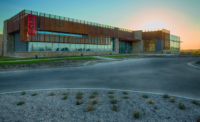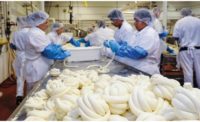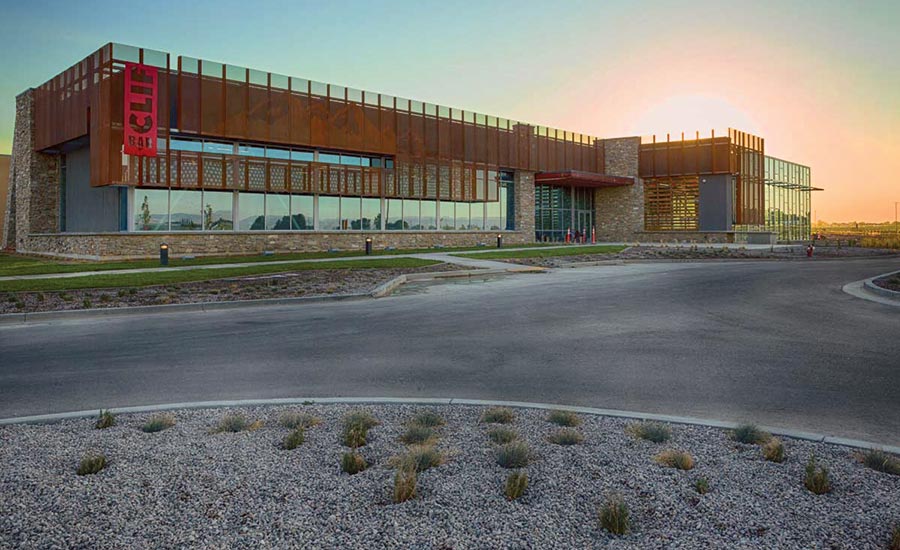Fabulous Food Plants
Clif Bar’s visual bakery project has the company ahead of the game

Clif Bar’s 5 Aspirations, as seen on the wall in this photo from the Indianapolis bakery, focus on supporting people, brands, community, business and the planet.
Photo courtesy of Clif Bar

Clif Bar’s Twin Falls, Idaho bakery, pictured here, was a greenfield implementation of the visual bakery project. The bakery won Food Engineering’s Sustainable Plant of the Year in 2017.
Photo courtesy of Clif Bar

The real-time data reporting and management available through the visual bakery system allows operators and managers to adjust on the fly.
Photo courtesy of Clif Bar



When Clif Bar launched its visual bakery project, the goal was to implement it in two bakeries almost simultaneously.
That goal was ultimately achieved, but not without some roadblocks along the way. The differences between implementation in a greenfield project in Twin Falls, Idaho, and an existing bakery in Indianapolis forced some adaptation and rethinking. In addition to the normal differences between greenfield and expansion/renovation projects, the company had to take into account Indianapolis’ existing workforce, which included multiple language barriers.
By being flexible, adaptable and committed to listening to and implementing feedback, the dual projects were a success, with Twin Falls coming online in May 2016 and Indianapolis going live in November 2016.
The Twin Falls bakery was named Food Engineering’s Sustainable Plant of the Year in 2017. The Indianapolis bakery has a different—although equally successful—story to tell. Transforming a traditional bakery into a visual bakery was a big challenge, especially considering it had to fit within Clif Bar’s 5 Aspirations, which the company defines as: sustaining our people, planet, community, brands and business.
That way of thinking was a big shift for the Indianapolis bakery, says Dave Tintelnot, general manager. He joined the Indianapolis team when Clif Bar originally purchased the bakery and began operating it with a copacker.
“The primary focus was to make bars and make money,” says Tintelnot. “Obviously, with Clif Bar, the community, the people, the planet are all very important as well.”
Those five bottom lines are evident in how the visual bakery platform has been designed, implemented and operated. Taken together, they show what a company can do when technological know-how and a dedication to a companywide culture—from the bakery floor to the C-suite—are combined to make a project successful.
The Business Case
The Indianapolis bakery first became a part of Clif Bar in 2014, when the company purchased the bakery and began making bars with a copacker. In 2016, Clif Bar took full control of the bakery and began implementing the visual bakery at the same time as the Twin Falls bakery was being built.
Twin Falls was built to be a state-of-the-art bakery, and aspects such as the ERP system, the operating systems and the PLCs were all top of the line. But that created a challenge when trying to install the same systems in Indianapolis, says Todd Wilson, senior vice president, IT.
“Not all of them were easily integrated into the Indy equipment,” says Wilson. “First and foremost, the PLCs. So things like our robotics or packaging, the PLC and proprietary software. So where it should have been plug and play like it was with Twin Falls, that was not the case, and we had to do an entirely different set of development to integrate some of those more antiquated systems.”
Another development challenge was understanding the target audience for the visual bakery system, says Ryan Bettilyon, business intelligence manager. He points out that many of the original ideas and requirements for the visual bakery came from the corporate and office sides of both the Twin Falls and Indianapolis bakeries.
“A lot of those office folks were wanting to go into the production lines, but then the production users said, ‘You know, we can already see this on some of our MES screens that exist. Here’s what we want to see for us to do our jobs,’” he says. “It was a lot of fine-tuning what content gets displayed in which locations to show useful information for the folks in the backend, as well as the folks who are not in the facility at all.”

Once those challenges were understood and successfully overcome, the visual bakery platform began to take shape. It’s an information system that provides operators, managers and corporate personnel the ability to get real-time data on what’s happening at every stage of production. Information is constantly updated on 75-inch monitors throughout the bakery, so production workers or supervisors can see what’s happening at a glance.
The monitors display location-specific information, so the monitors at mixing stations are displaying different information than the monitors at wrapping stations, which display different information than the monitors at palletizers. The information is also available on iPads and through a web-based interface, which gives employees a number of different ways to have instant access to production data.
The information is provided to help production personnel and on-site managers understand what’s going on with their production lines and effectively operate them, giving them better data to help make decisions in real time. The data can be remotely monitored as well, but Wilson says there are restrictions on how data can be monitored and used by employees who are not on-site.
Short interval control huddles are another real-time tool the company uses to ensure it’s hitting production goals. With extensive data available in real time, key team members will meet and study the analytics to see how production is running and what improvements can be made during the course of a shift instead of having to wait for reports after shifts. Those decisions are logged as a reference for other employees and other shifts to create an ongoing reference material for operators and managers to understand and implement strategies for more effective and efficient operation.
“We have operators that are able to make real-time decisions that they were not able to make in the past, and that’s resulted in some substantial savings, through yield loss, through operational efficiency on the equipment, through quality,” says Wilson.
The bakeries also have weekly meetings where they look at data and operating trends to identify areas of improvement that can be displayed on every dashboard throughout the bakery. The system incorporates enough flexibility to allow the team to decide on and display metrics and performance goals for every aspect of production.
“We may decide to focus on safety and certain aspects of safety, so we want to monitor how we’re doing in respect to safety,” says Wilson. “The next month it may be around yield, especially if we’ve seen any kind of dip in yield. We’ll then focus on yield and that will be a part of every dashboard no matter where you are.”
The real-time data and the ability to make decisions based on it are the critical components of the visual bakery, says Bettilyon. The production screens show the status of every machine on the line, from extruders and mixers at the beginning to the palletizers at the end. Machines report their status and operators can see how long a machine has been operating properly or how long an issue has been going on if an error message is shown.
Clif Bar collected extensive data before the visual bakery system, but not in a way that allowed for real-time decision making, says Bettilyon.
“It was just history of production data. The one thing that was really missing before visual bakery was folks just didn’t have any sense of, ‘Are we on track today? Are we not on track today? What do we need to do?’”
People Power
In Twin Falls, Clif Bar was hiring new employees. But in Indianapolis, there was an existing workforce that included numerous employees with decades of experience. In addition, there were three languages spoken among that workforce: English, Spanish and a couple different dialects of Burmese.
“Where we were training brand new employees in Twin Falls, now we’re training employees that were used to doing something a certain way for a very long time,” Wilson says.
Those employees had to be trained on new systems and processes for operations and food safety, and the multiple languages presented another challenge. To successfully navigate this, the company focused on identifying and working with leaders among the workforce to help employees understand and implement the changes.
“It took far more effort than we initially expected on the overall training, but the approach we ended up taking really was an effort to get some engagement from those teams,” says Wilson. “When we started building out this training curriculum, we would identify key leaders within each one of the teams and do so not as much by function as much as by language. So we’d have a certain amount of language barriers overcome simply because key people that are involved in the training.”
“We had to have the humility and desire to learn from [our] teams, really listen to the types of inputs they were providing and sometimes engage in a way that drew it out of them.”
– Todd Wilson
In addition to the language barrier, other cultural differences presented challenges. Some employees are more likely to ask questions based on their cultural background, while others remain quiet unless they are told to speak up. Those key leaders in the workforce helped overcome those challenges as well.
“We had to have the humility and desire to learn from those teams, really listen to the types of inputs they were providing and sometimes engage in a way that drew it out of them,” says Wilson. “Because it wasn’t just natural for some of those key representatives to speak their minds or to provide input on what was going to be more effective.”
Adapting to the Clif Bar way and the visual bakery was a challenge not only for the workforce but also for leadership, says Tintelnot. He and other leaders in the bakery were also used to the traditional manufacturing style—make bars and make money—and the visual bakery implementation was a new world for them as well. Leadership focused on leading by example to acknowledge when they made mistakes or were still caught up in the way they’d done it before.
“There were times where some of our leaders got caught up in that traditional manufacturing, and we had to go back and kind of apologize and retract things and show how we’re different, and then show leaders how to think of things differently,” he says.
“There was no blueprint on how to run a five-aspirations bakery. There were mistakes made along the way, and we were upfront about it with the employees and what happened, and that’s how we started to earn their trust and show them things were different.”
As the visual bakery project moved from training and implementation to day-to-day operations, the company remained focused on eliminating possible confusion from language barriers or other communications breakdowns. The information is presented in numeric form, with targets and progress. Color-coding—with color blindness accounted for as well—is also prominently used, so even employees who don’t have English as their first language can look at and understand what the colors and numbers are reporting.
The one exception is reason codes, says Wilson.
“We have reason codes where we track things like why did the extruder stop? Why did the wrapper stop? And in most cases, we have steps in a single language, it’s in English, but also with reference guides that are posted next to their stations so that they’ve got translations,” says Wilson.
Most employees figure out pretty quickly what the reason codes mean and how to respond, so the translation often isn’t needed. But for employees that are new and still training, there’s a chart with a barcode for each of the reason codes, and the reason code is described in the three different languages spoken and read by Indianapolis employees.
Training and day-to-day operations are one area of focus for Clif Bar’s aspiration focused on people. But it extends beyond that. While there are often differences in how employees in management or the corporate office are treated compared to production personnel, Clif Bar has tried to eliminate those differences as much as possible.
“We have very few differences, and those differences are essentially unavoidable,” says Wilson. “We offer the ability to bring your dog to work in our corporate offices and in our sales offices. That’s not possible in a GMP food production area, so that’s one of the differences, right?”
Clif Bar is family- and employee-owned. The company has an employee stock ownership plan (ESOP), which was originally shared among about 500 corporate employees. But the company effectively tripled the number of employees involved by opening it up to production personnel, even though that meant some corporate employees saw significant dilution in their holdings.
That was a big thing. There was also a relatively little thing done at the Indianapolis bakery during the renovation, but it was still a significant change. Most manufacturing facilities have different doors for different types of workers, often broken down into hourly (production) entering one door and salary (corporate) entering another.
“For us, it’s the same entry,” says Wilson. “It was two classes of employees, and we wanted to eliminate that.”
Sustaining the Planet and the Community
Sustainability is a cornerstone of Clif Bar’s company culture and is always a consideration in design, operation, and equipment specification and operation. The company’s headquarters and bakeries are LEED certified, and the bakeries are pursuing zero waste certification, with the goal of attaining it this year.

Beyond that, the company offers a number of incentives for employees to cut down on pollution caused by commuting to help fight the effects of climate change. Employees have access to incentive programs for purchasing a bicycle for commuting, buying electric or hybrid vehicles, and eliminating cars entirely from their commute by walking, biking, carpooling or using public transportation.
Sustainability is also often a focus of the company’s volunteer efforts, which the company encourages by providing paid time off for employees to volunteer. Employees in Idaho have planted thousands of trees and saplings, both as part of their individual efforts and in support of the Bureau of Land Management after forest fires.
The company and its employees support their communities in other ways as well. Indianapolis employees take part in the Million Meal Movement, to pack meals for food banks and food pantries. To date, employees in Indianapolis have packed more than 500,000 meals for the program. Employees have also taken part in volunteer activities such as helping to clean up the Ohio River.
The bottom lines
The visual bakery effort has provided Clif Bar with resources and data that were previously unavailable, allowing for better operating efficiency, sustainability, reduced waste and higher yields. In one way or another, it connects to each of the company’s aspirations.
But it wouldn’t have worked without putting people first, says Wilson. If it had been simply a top-down directive, language barriers and other challenges would have made training and implementation difficult, if not impossible. By bringing operators and other on-site employees into the process early on and accepting their feedback, the company was able to realize the platform’s full potential by getting employees engaged and invested in its success.
“We’re at such a different point now, because we really do have engagement on the shop floor,” says Wilson. “So this visual bakery that we did, that’s really been a game changer across both bakeries. We’ve now gotten to the point where we’re aligned on standardization across both bakeries, aligned on the cultural standardization across our corporate settings as well as the two bakeries. That would have been impossible to achieve in the early days when we’re onboarding two very different groups of workforce.”
Ultimately, the ability of the entire visual bakery team to adapt, adjust and listen to what was needed helped ensure the visual bakery would be that game changer that Wilson describes it as.
“It is roughly 35 people across both bakeries and our headquarters, all very aligned, all working toward the same goal, even though it was multiple languages, even though there still continue to be some differences across the equipment, and even in some cases, the processes,” Wilson says.
“It’s a complete 180 from where we started.”
Looking for a reprint of this article?
From high-res PDFs to custom plaques, order your copy today!












